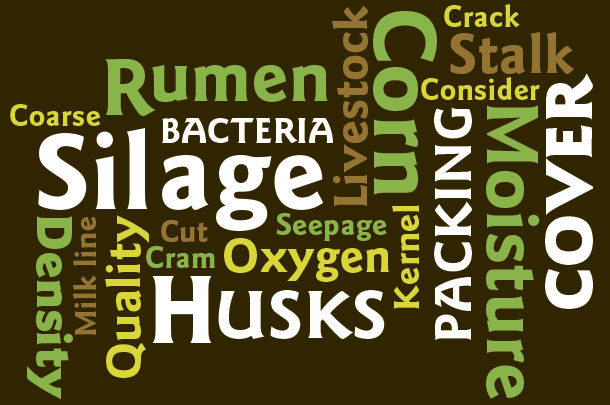Feed accounts for the largest cost of production in most livestock operations, and many beef and dairy cattle producers are constantly looking for economic and effective ways to feed their livestock. Including more forage can lower the cost of a ration – as long as it is high quality!
Corn silage is unique in that it contains both grain and forage. This combination provides animals with dense energy in kernels and rumen-stimulating fiber from leaves, stalk and husk. This forage is a remarkable feedstuff not only in dairy rations, but it can be a great asset in beef operations as well. Corn silage can be fed as supplemental forage on pasture or confinement and is a key source of energy and roughage for feedlot cattle.
The following are key aspects in producing high-quality corn silage.
Consider moisture content
Moisture content is crucial to determine the proper time to harvest corn silage. Proper moisture content allows for good compaction and provides an optimal environment for bacteria to ferment sugars and produce desirable acids. The range in moisture typically oscillates between 60 to 70 percent, with an optimal average of 65 percent. Corn silage that is too wet (more than 70 percent moisture) can result in seepage and development of undesirable bacteria, such as clostridium, which will increase dry matter loss and decrease palatability. On the other hand, if the material is too dry (less than 60 percent moisture), it is hard to pack and exclude air out of the ensiling material. This can result in low density and high spoilage due to respiration, and growth of yeast and molds.
Dry matter and a visible milk line are used as indicators of corn silage maturity. It can be expected that corn plants will dry down 1 to 0.5 percentage point each day, allowing producers to estimate the right time to harvest. Corn plant maturity and drying down is related to the deposition of starch in the kernel, or formation of the milk line. The milk line should be between two-thirds and three-quarters of the kernel for optimal starch deposition, and starch content can increase almost 1 percentage point a day.
Cut (theoretical length of cut)
The theoretical length of cut (TLC) for processed corn silage is 3/4 inch or the width of a penny; if the forage is not processed, then the TLC should be 1/4 to 1/2 inch. If chop length is too coarse, it becomes difficult to pack and there could be problems due to spoilage and poor fermentation. Correct particle size can also drive feed intake and rumen fermentation. This can be double-checked using a particle size separator, also known as a “shaker box.”
Crack (kernel processing)
Kernel processing literally unlocks the energetic potential of the starch contained in the corn kernels. Properly processed corn silage should have no whole kernels, and no pieces of cob should be visible. Even though a sample of corn silage may contain significant starch, digestibility of starch may differ because the outer layer of the kernels is not processed and rumen microbes have limited access to ferment the starch. The combination of crushing (1 to 3 millimeter roller gap) and shearing action through differential speed helps break kernels apart.
Even though the kernel processing score can be determined by a forage lab (a score less than 50 is inadequate; 50 to 70 is adequate; and more than 70 is ideal), it does not allow for immediate decisions during the harvesting process. Therefore, it is highly recommended to monitor processing during harvest to be able to make adjustments “on the fly.” This can be tested using the 32-ounce cup method (less than two full or partially damaged kernels per cup is desired).
Cram (packing)
Tight packing and complete sealing allows oxygen removal, which is essential for growth of anaerobic lactic acid bacteria. These bacteria are responsible for converting sugars into lactic acid, thus preserving the silage. It is recommended to calculate the capacity for packing prior to harvesting to ensure that enough weight is available and that fresh forage is delivered at the appropriate rate to achieve desired density. Target density at 15 pounds dry matter per cubic foot or more (researchers at the University of Wisconsin – Madison have developed a spreadsheet calculator to estimate silage density, which is available online).
Cover
Proper sealing of silage using an oxygen barrier film and black and white plastic will decrease loss of dry matter and nutrients. Lining bunkers prior to filling is another way to prevent spoilage around edges of the bunker. Additionally, weight is needed to keep the plastic covers down and prevent infiltration of air; tires on top of the plastic cover are the most common method. Using sidewalls or perforated tires reduces risk of water accumulation (breeding grounds for mosquitoes). This is a labor-intensive task, but the benefits are much greater because well-preserved silage means greater recovery of dry matter, less nutrient loss and overall better feed. The ideal silage should be covered with tires touching each other – big or small piles, it is possible!
The time, money and effort invested in a high-quality process can pay big dividends as the results represent the base for future feed. Therefore, it is important to make every effort possible to harvest, store and feed high-quality forage. ![]()

-
Hugo A. Ramírez Ramírez
- Assistant Professor
- Iowa State University
- Department of Animal Science
- Email Hugo A. Ramírez Ramírez
Brooke C. Dooley is a graduate research assistant at Iowa State University.
PHOTO: Illustration by Corey Lewis.











